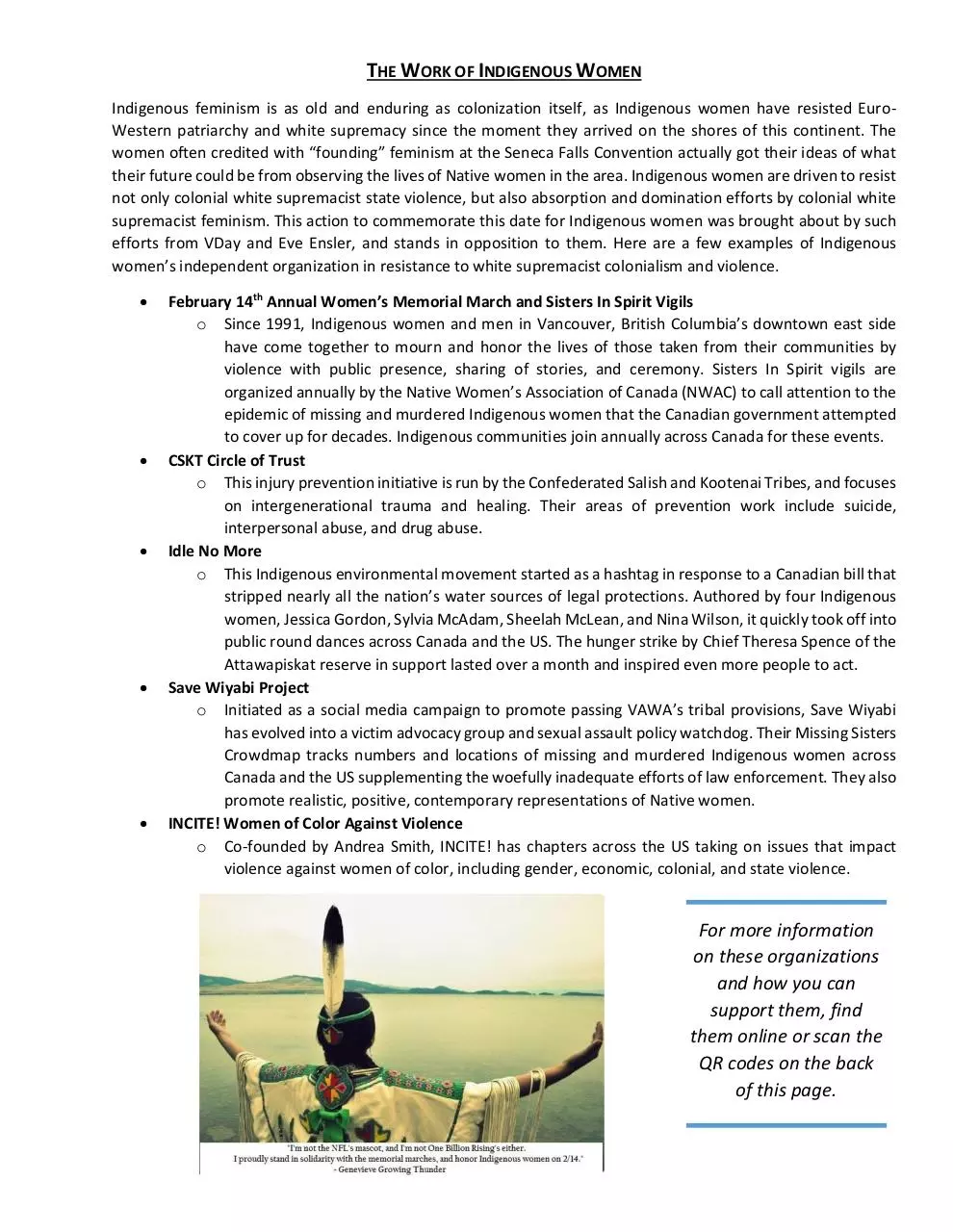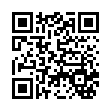Save Wiyabi 2 14 Info Sheets (PDF)
File information
Author: Kelleigh Driscoll
This PDF 1.5 document has been generated by Microsoft® Word 2013, and has been sent on pdf-archive.com on 12/02/2014 at 04:37, from IP address 174.29.x.x.
The current document download page has been viewed 895 times.
File size: 1.67 MB (8 pages).
Privacy: public file





File preview
2/14: GLOBAL DAY FOR MISSING AND MURDERED INDIGENOUS WOMEN
AND COMMUNITY ACCOUNTABILITY
To assert Indigenous feminisms, demand a move toward community-based solutions, and oppose all
harm against Indigenous women.
RESISTING EVE ENSLER, VDAY, AND COLONIAL FEMINISM
2/14 as the Global Day for Missing and Murdered Indigenous Women and Community Accountability is resistance
to more than the white supremacist colonialism stealing the lives of Native women through physical violence. It
is resistance to the erasure and absorption efforts of colonial feminism, specifically exemplified by Eve Ensler and
VDay. The needs, goals, and methods of Indigenous women and communities differ from the aims of powerful
and socially privileged organizations such as VDay, yet they consistently impose their agendas on those
communities. They are also actively invested in avoiding issues necessary to face for dismantling violence against
women of color, especially white supremacy and how white women benefit from and participate in harm against
women of color under it. When the work of women of color who focus on this is co-opted to bolster VDay’s image,
they actively erase these crucial aspects, doing violence to the work and voices of these women. The depth of this
investment in protecting the public images of these organizations means when women’s grassroots work is a
threat to it, they use their greater funding and media power to silence that work. This pattern is exemplified by
VDay and One Billion Rising’s treatment of Indigenous women in Canada, which catalyzed today’s action.
Last year, One Billion Rising perpetuated an especially egregious usurpation against Indigenous women who had
been organizing memorial marches for their missing and murdered on February 14th for decades, starting years
before VDay was even founded. In 2013, OBR decided to use this same day to “spotlight” indigenous women.
However, this only amounted to sharing statistics of violence against them, while failing to mention the marches
that represented decades of work by and for the actual Indigenous women in the area. This attempt to “raise
awareness” actually erased their hard work and resistance, reducing their representation to one-dimensional
caricatures of victimhood. March organizers brought their concerns about this to the VDay organizers. They asked,
since they wanted to spotlight them, that VDay select a different date or if not, spotlight them by supporting the
marches. VDay said they would support and publicize the marches only on the condition that participants wore
VDay’s pink t-shirts and performed VDay’s song and dance. Demanding these Indigenous people replace the songs
and dances they selected because of deep significance to their communities with VDay’s to get their support, even
as they claimed to be “spotlighting” those women, was a profoundly colonial manifestation of feminism.
VDay has gone to great lengths to hide this, and to bolster their image of “diversity” through strategic hiring and
donations instead of taking public accountability and altering core practices. It was not until after a major outcry
led by Native women on social media that Eve Ensler quietly issued a statement and VDay in Canada grudgingly
moved their date. They have remained conspicuously silent about it, and despite their immense media power,
have failed to publicize the fact that 2/14 in Canada is reserved for Indigenous women. This avoidance leaves
ample room for media whose attention is already on VDay and Eve Ensler, to conflate Indigenous women’s
activities on this date with them when many are in direct opposition to them and resisting harm done at their
hands. Attempts to dominate and assimilate Indigenous women’s activism, to erase the crucial differences in their
experiences, goals, and methods of activism, will not be tolerated. Today, we speak out for Indigenous women
against white supremacist colonial violence targeting both their bodies and their voices.
FOR MORE INFORMATION ON THE COLONIAL VIOLENCE OF EVE ENSLER, ONE BILLION RISING, AND VDAY AGAINST
INDIGENOUS AND OTHER WOMEN OF COLOR, PLEASE SCAN THE QR CODES ON THE BACK OF THIS PAGE.
Lauren Chief Elk:
“Open Letter to
Eve Ensler”
Mariame Kaba:
“One Billion Rising,
Eve Ensler, and the
Contradictions of
Carceral Feminism”
Andrea Smith’s
“Beyond Eve Ensler:
What Should
Organizing Against
Gender Violence Look
Like?”
THE WORK OF INDIGENOUS WOMEN
Indigenous feminism is as old and enduring as colonization itself, as Indigenous women have resisted EuroWestern patriarchy and white supremacy since the moment they arrived on the shores of this continent. The
women often credited with “founding” feminism at the Seneca Falls Convention actually got their ideas of what
their future could be from observing the lives of Native women in the area. Indigenous women are driven to resist
not only colonial white supremacist state violence, but also absorption and domination efforts by colonial white
supremacist feminism. This action to commemorate this date for Indigenous women was brought about by such
efforts from VDay and Eve Ensler, and stands in opposition to them. Here are a few examples of Indigenous
women’s independent organization in resistance to white supremacist colonialism and violence.
February 14th Annual Women’s Memorial March and Sisters In Spirit Vigils
o Since 1991, Indigenous women and men in Vancouver, British Columbia’s downtown east side
have come together to mourn and honor the lives of those taken from their communities by
violence with public presence, sharing of stories, and ceremony. Sisters In Spirit vigils are
organized annually by the Native Women’s Association of Canada (NWAC) to call attention to the
epidemic of missing and murdered Indigenous women that the Canadian government attempted
to cover up for decades. Indigenous communities join annually across Canada for these events.
CSKT Circle of Trust
o This injury prevention initiative is run by the Confederated Salish and Kootenai Tribes, and focuses
on intergenerational trauma and healing. Their areas of prevention work include suicide,
interpersonal abuse, and drug abuse.
Idle No More
o This Indigenous environmental movement started as a hashtag in response to a Canadian bill that
stripped nearly all the nation’s water sources of legal protections. Authored by four Indigenous
women, Jessica Gordon, Sylvia McAdam, Sheelah McLean, and Nina Wilson, it quickly took off into
public round dances across Canada and the US. The hunger strike by Chief Theresa Spence of the
Attawapiskat reserve in support lasted over a month and inspired even more people to act.
Save Wiyabi Project
o Initiated as a social media campaign to promote passing VAWA’s tribal provisions, Save Wiyabi
has evolved into a victim advocacy group and sexual assault policy watchdog. Their Missing Sisters
Crowdmap tracks numbers and locations of missing and murdered Indigenous women across
Canada and the US supplementing the woefully inadequate efforts of law enforcement. They also
promote realistic, positive, contemporary representations of Native women.
INCITE! Women of Color Against Violence
o Co-founded by Andrea Smith, INCITE! has chapters across the US taking on issues that impact
violence against women of color, including gender, economic, colonial, and state violence.
For more information
on these organizations
and how you can
support them, find
them online or scan the
QR codes on the back
of this page.
February 14th
Annual Women’s
Memorial Marches
Sisters In Spirit
INCITE! Women of
Color Against Violence
CSKT
Circle of Trust on
JADE WILLOUGHBY
Idle No More
SUPPORTING
SAVE WIYABI PROJECT
Save Wiyabi Project:
Missing Sisters
Crowdmap
UNIQUE ISSUES FACED BY INDIGENOUS WOMEN
Colonization, the forcible imposition of the American state and Euro-Western cultures, is an ongoing process. It
has introduced and maintained a number of specific forms of violence against Native women by virtue of their
being Native. These include but go beyond these examples of physical, state, and environmental violence.
PHYSICAL VIOLENCE, SEXUAL VIOLENCE, AND STATE VIOLENCE
Historically, rape, murder, and mutilation of Indigenous women were actively used as military tactics to
achieve submission of Native peoples during the settlement of the United States, and violence against
Native women continues to be a cornerstone of the state’s functions. Sexual attacks against Native
women were not viewed by their perpetrators as rape because the target must be human for that qualifier
to apply. This concept persists today, and they are almost three times more likely to be raped in their
lifetime than white women. Amnesty International finds 86% of those perpetrators are non-Native,
especially white men.
Tribes currently lack full authority to prosecute any crimes by non-Natives. Native women are especially
targeted because rapists and batterers are aware of the lack of consequences. Although the VAWA
reauthorization of 2012 restored very limited jurisdiction, most crimes committed on tribal lands are still
considered under the jurisdiction of the FBI, who almost never bother to prosecute crimes against Native
women. This supports and enables violence against them. The FBI has consistently shown greater
willingness to prosecute Native women than to protect them.
FORCIBLE REMOVAL FROM COMMUNITIES
Federal jurisdiction makes Native women vulnerable to draconian prosecution and prison terms for even
the most benign of legal violations. It makes shoplifting a pack of gum into a federal crime. Despite
debilitating effects of severe trauma, Dana Deegan is serving a 10 year sentence over the same crime for
which a non-Native woman received six months’ probation. Incarceration of Native women is a form of
forcible removal from their families, children, and communities, state violence affecting both individuals
and communities.
SIGN THE CLEMENCY PETITION FOR DANA DEEGAN—SCAN HERE WITH YOUR SMARTPHONE!
(Photo from change.org)
Disproportionate incarceration of Native women also contributes to theft of children from their
communities, as states often take custody when mothers go to jail. Forcible removal of children is another
tactic of colonization, with historical roots in boarding schools and current manifestations in adoption and
foster care. A discourse of Native people as inherently incompetent parents persists from boarding school
days. Native parenting is increasingly criminalized, and states receive funding for each taken Native child.
Like with boarding schools, this form of child trafficking removes Native children from their parents with
brutal casualness. They are overwhelmingly sent to non-Native custody, where they face not just isolation
from their cultures and forced assimilation, but shocking rates of physical and sexual abuse. The Indian
Child Welfare Act (ICWA) was developed in response to the Indian Adoption Act, a law which encouraged
the removal of Indian children specifically into white homes, but is still broadly misunderstood and
delegitimized in courts, and violated on a systematic scale.
POLICE VIOLENCE
Part of the state violence imposed on Native women is that which comes at the hands of police officers.
Amnesty International reports that in the US, Native women overwhelmingly describe feeling unable to
trust police when they need help, because police almost ubiquitously re-traumatize them, specifically with
racist and sexist violence. The recent Human Rights Watch report “Those Who Take Us Away,” based on
research conducted in Canada, indicates astonishing rates of sexual assault and beatings committed by
police against Indigenous women. Police as a source of violence creates a double-bind for Indigenous
women in both the US and Canada, as they face not only that violence itself, but the fact that it means
they have no formal outlets of support when violence is committed against them.
Human Rights
Watch News:
“Those Who Take
Us Away:
Abusive Policing
in Canada”
Amnesty
International:
Maze of Injustice
Report
ENVIRONMENTAL VIOLENCE
Environmental racism is also uniquely tied to violence against Indigenous women. The acquisition of the
land on which the United States now stands, and the resources in which it is economically invested, was
based on rape and murder of Indigenous women as a means of conquest and removal. Resource
extraction continues to be a source of violence against Indigenous women, both environmentally and
physically. There is a direct, demonstrable link between the presence of resource extraction crews and
sexual attacks on Native women. Oil lobbies spent vast sums fighting restoration of some jurisdiction to
tribes through VAWA’s tribal provisions because accountability for attacking Native women interferes
with their operations when the attackers are their employees.
Additionally, poisons left behind by resource extraction disproportionately impact Native women. High
rates of serious illnesses, premature death, and infant mortality faced by Native women are linked to the
poisoning of their environments. Most of the prime oil, natural gas, and uranium deposits within the
boundaries of the United States are under or near tribal lands, and these are also some of its most toxic
places. Under colonial ideology Indigenous lands, like the peoples, have always been considered vacant
and in need of development. This continues to justify harmful polluting activities such as resource
extraction, waste dumping, and nuclear testing in those areas.
Video: CONQUEST, Sexual
Violence & American Indian
Women, by Andrea Smith
(Book Available from South End Press)
Download Save Wiyabi 2-14 Info Sheets
Save Wiyabi 2-14 Info Sheets.pdf (PDF, 1.67 MB)
Download PDF
Share this file on social networks
Link to this page
Permanent link
Use the permanent link to the download page to share your document on Facebook, Twitter, LinkedIn, or directly with a contact by e-Mail, Messenger, Whatsapp, Line..
Short link
Use the short link to share your document on Twitter or by text message (SMS)
HTML Code
Copy the following HTML code to share your document on a Website or Blog
QR Code to this page

This file has been shared publicly by a user of PDF Archive.
Document ID: 0000146323.